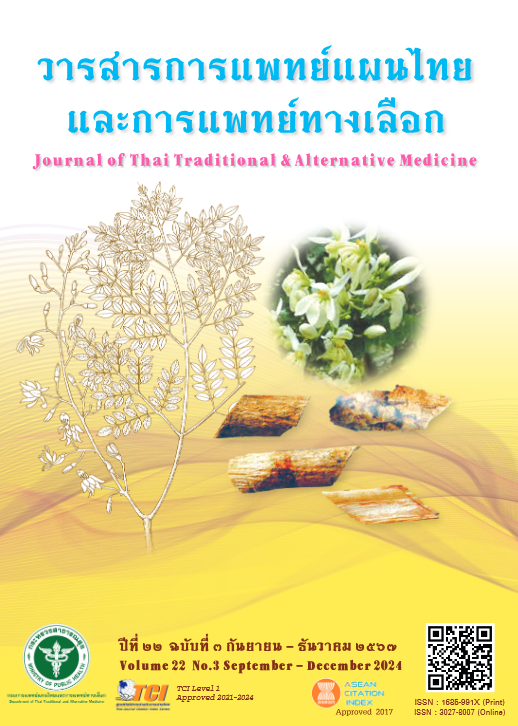Production of Delta-9-Tetrahydrocannabinol Reference Standard from Cannabis sativa L.
Main Article Content
Abstract
Introduction and objectives: Thailand's cannabis policy, which permits the medical use of cannabis, has led to increased production and research of cannabis-derived products. Ensuring the quality control of cannabis extracts and products to meet safety standards and legal requirements necessitates the use of a standard substance, delta-9-tetrahydrocannabinol (delta-9-THC), for comparative analysis in quantifying active compounds. The Bureau of Drug and Narcotic, Department of Medical Sciences, has undertaken the production of delta-9-THC reference standard to support national policy and reduce the ongoing reliance on imported reference standards.
Methods: Delta-9-THC was extracted and isolated from the inflorescence of cannabis using supercritical fluid extraction (SFE) with a suitable ratio of carbon dioxide to ethanol. The resulting extract was further purified using supercritical fluid chromatography (SFC) to obtaining delta-9-THC. The identity of the compound was confirmed through IR spectroscopy, mass spectrometry, and ¹H-NMR spectroscopy, and purity was analyzed using high-performance liquid chromatography (HPLC) prior to its establishing as a Department of Medical Sciences reference standard.
Results: The application of SFE with a carbon dioxide to ethanol ratio of 95:5 suitably produced a cannabinoids-rich extract. Subsequent purification of cannabinoids-rich extract via SFC achieved delta-9-THC with 99.4% purity, calculated on the as is basis, obtaining a yield of 0.6%. The produced delta-9-THC reference substance, formulated in methanol solution, adhered to ISO 17034:2016 standards for reference material production. Stability assessments indicated that the substance maintained its integrity when stored at 2–8°C over a three-year period. The homogeneity studies demonstrating uniformity throughout production batch. The certified concentration with associated uncertainty of the standard was determined to be 0.9303 ± 0.0792 mg/mL.
Discussion: The use of SFE and SFC under developed conditions enabled the selective isolation of delta-9-THC from other cannabinoids, achieving >99% purity. This method presents minimal environmental and health impacts compared to traditional organic solvents.
Conclusion and recommendations: The produced standard substance can be utilized for analyzing delta-9-THC amounts in cannabis plants, extracts, and products, ensuring the quality of domestically produced medical cannabis products. Furthermore, it serves as a resource for research, efficacy testing, toxicity assessment, and the determination of active ingredient dosages in future medical applications.
Article Details

This work is licensed under a Creative Commons Attribution-NonCommercial-NoDerivatives 4.0 International License.
References
Simiyu DC, Jang JH, Lee OR. Understanding Cannabis sativa L.: Current Status of Propagation, Use, Legalization, and Haploid-Inducer-Mediated Genetic Engineering. Plants. 2022;11:1236.
Narcotic Act B.E. 2522 (1979). Published in Government Gazette. (1979 Apr 22). (in Thai)
Ministry of Public Health. A manual for preparing individual medicines for traditional Thai medical cannabis medicines, (The part that is not a harmful drug) for public health service units. Nonthaburi: Ministry of Public Health; 2022. (in Thai)
Narcotics Act (No. 7) B.E. 2562 (A.D. 2019). Published in Government Gazette, (2019 Feb 18). (in Thai)
United Nations Office on Drugs and Crime. Recommended methods for the identification and analysis of cannabis and cannabis products. New York: United Nations Office on Drugs and Crime; 2009. p. 41-3.
American Herbal Pharmacopoeia. Cannabis Inflorescence. Cannabis spp., Standards of Identity, Analysis, and Quality Control, Scotts Valley. CA: American Herbal Pharmacopoeia; 2014. p. 44-7.
Pavan MVR, Barron AR. Basic principles of supercritical fluid chromatography and supercritical fluid extraction, physical methods in chemistry and nano science. Houston: Rice University, LibreTexts; 2024. p. 229-41.
European Medicines Agency. ICH harmonised tripartite guideline stability testing of new drug substances and products Q1A(R2). London: European Medicines Agency; 2003. 24 p.
ISO 33405: 2024. Reference materials - Approaches for characterization and assessment of homogeneity and stability. Geneva: International Organization for Standardization (ISO); 2017.
ISO 17034: 2016. General requirements for the competence of reference material producers. Geneva: International Organization for Standardization (ISO); 2016.
European Medicines Agency. ICH Topic Q 1 E : Evaluation of Stability Data. London: European Medicines Agency; 2006. 17 p.
Azmira J, Zaidula ISM, Rahmana MM, Sharifa KM, Mohameda A, Sahenab F, Jahurul M.H.A., Ghafoor K, Norulaini N.A.N, Omar A.K.M. Techniques for extraction of bioactive compounds from plant materials: A review. J Food Eng. 2013;117:426-36.
Gallo-Molina AC, Castro-Vargas HI, Garzón-Méndez WF, Martínez Ramírez JA, Rivera Monroy ZJ, King JW, Parada-Alfonso F. Extraction, isolation and purification of tetrahydrocannabinol from the Cannabis sativa L. plant using supercritical fluid extraction and solid phase extraction. J Supercrit Fluids. 2019;146:208-16.
Laura JR, Niccolo VA. Supercritical carbon dioxide extraction of cannabinoids from Cannabis sativa L. J Supercrit Fluids. 2017;129:16-27.
Wang M, Wang Y-H, Avula B, Radwan MM, Wanas AS, Antwerp JV, Parcher J.F, ElSohly M.A, Khan I.A. Decarboxylation study of acidic cannabinoids: a novel approach using ultra high-performance supercritical fluid chromatography/photodiode array-mass spectrometry. Cannabis Cannabinoid Res. 2016;1(1):262-71.
Zala SP, Patel KP, Patel KS, Parmar JP, Sen DJ. Laboratory techniques of purification and isolation. Int J Drug Dev & Res. 2012;4(2):41-55.
Matthew P, David AK. The SFC isolation and purification of cannabinoids using application specific stationary phases under optimised conditions. Chromatography Today. 2020;43-6.
Tay L-L, Hulse J, Paroli RM. FTIR and raman spectroscopic characterization of cannabinoids. Can J Chem. 2022;100(10):751-8.


